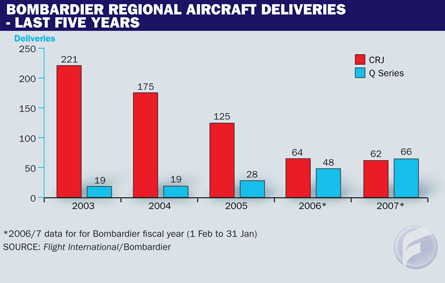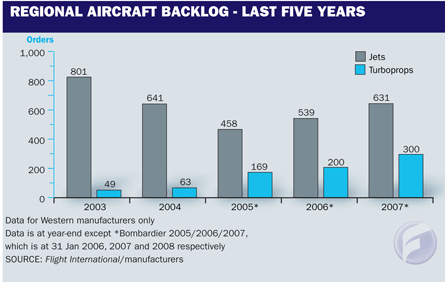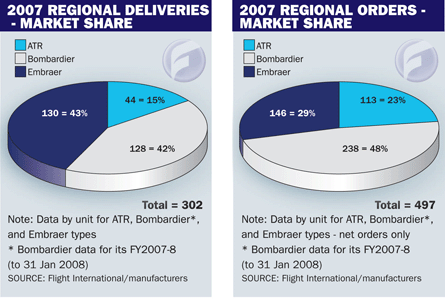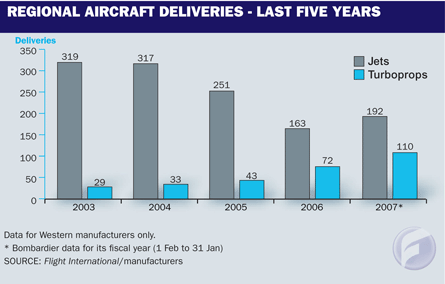Orders and deliveries for ATR and Bombardier Q Series rise significantly as sector's recovery gathers momentum
The regional sector is experiencing a strong revival, with orders and deliveries in 2007 up by around 30% and 45% respectively on the year before, and backlog rising by quarter. The turboprop airliners led the charge with both ATR and Bombardier recording strong sales and boosting output to the highest levels since the beginning of the decade.
Total regional net orders were just shy of 500 last year (497 orders - 287 jets and 210 turboprops), compared with 346 in 2006. Bombardier was the lead supplier in sales terms, securing 238 net orders during its 2007/8 fiscal year, which ended on 31 January. The Canadian airframer was helped by its diversified product line - with president Pierre Beaudoin citing "significant demand for larger regional jets and turboprops".

With demand having shifted away from the 50-seat jets (Bombardier's CRJ200 is now out of production), net orders for the 70-seat CRJ recovered in 2007 with 33 orders, but it was the CRJ900 and new CRJ1000 large regional jets that drove jet sales, accumulating 108 orders. Meanwhile, the Q Series turboprop had a good year, ending the 12 months with a tally just short of 100 orders.
Richard Aboulafia, vice-president analysis at Teal Group, says that Bombardier has proved some doubters wrong with the larger CRJ models, where their lower cost of acquisition and operation have allowed continued success in the face of strong competition from the all-new Embraer E-Jets.
"There is a comfort issue with them on longer routes, but the CRJ's lower costs means that it works well on shorter 1h sectors," he says. "But you can't push the low-cost thing for too long, and the problem is that the trend is for regional jets to be deployed on longer routes, where the E-Jet is more suitable."
Although Embraer was the lead regional jet supplier in order terms, overall its net sales declined by a quarter in 2007 to 146, from 199 in 2006. This was only slightly ahead of Bombardier's 141 jet orders.
ATR was top in the turboprop sector, setting a personal best sales performance of 113 orders. Overall, turboprop orders more than doubled during 2007 to 210, from 97 the year before.
Shipments
Regional airliner shipments increased from 235 in 2006 to 302 aircraft. Embraer was the market leader, with its airliner production rising by a third in 2007 to 130 aircraft. This put the Brazilian company marginally ahead of rival Bombardier's 128 shipments, with the former's E-190 jet's 68 deliveries making it the single most popular regional aircraft in 2007.

Last year was a watershed for turboprop production at Bombardier, with deliveries of its Q Series outstripping CRJ regional jets for the first time in more than a decade. The airframer shipped 66 Q Series - 50% more turboprops than rival ATR - and 62 CRJs, for a total of 128 aircraft. This was a 14% increase on the previous year's tally of 112 aircraft.
Turboprop production increased by over 50% in 2007 and broke the 100 aircraft threshold for the first time since 2000 (when there were five suppliers), accounting for more than a third of total regional airliner shipments.
The most popular aircraft size category overall was the large regional jet (more than 80 seats), with a total of 134 deliveries.
While there is no doubt that the turboprop turnaround is here to stay for the time being, the big question is: when will propeller-driven airliner sales make a genuine recovery in the US market? Aboulafia believes there will be a gradual recovery in the US market, with "10 orders here and 20 there, but that all adds up to something significant as North America represents 60% of the world regional market".
There are signs that this is already under way, with ATR chief executive Stephane Mayer revealing earlier this year that the airframer has responded to an undisclosed US carrier's request for proposals for around 20 large turboprops: "The process is in the hands of the customer," he says. "This would be our first [new US airline] order in at least 10 years."

Aboulafia believes the recovery of the US market is "key" to the development of larger or all new turboprops from ATR and Bombardier: "I wouldn't say it is the driver, but it is an enabler. You could justify the development of a new or larger turboprop on the back of North American demand."
One of the benefits a larger 90-100 seat category turboprop could bring would be its ability to circumnavigate pilot scope clauses, says Aboulafia, which can limit the amount of flying that regional airlines can fly for mainline carriers with jets. He believes that most scope clauses are unlikely to include 90-100 seat turboprops "on the basis that we've not had that size of aircraft since the [Lockheed] Electra".

Bombardier has been studying a 90-seat "Q400X" for a year or so, while ATR is examining whether a stretch or an all-new design should be its next move.
Aboulafia believes a Q400X stretch is a "nice to have" rather than a "must do" derivative unless it is used as a "springboard to rejuvenate the Q Series family".
He also fears that with Bombardier's traditionally measly approach to research and development spend, the Q400X may only become a reality if CSeries ends up being dropped, as otherwise "they won't have any money left" to develop the new turboprop.
The regional order backlog has risen by a quarter to 931 aircraft, around a third of which are turboprops (up from 27% at the end of 2006). Almost half of the backlog is for large regional jets (80 seats and greater).

Embraer remains market leader in backlog with 476 orders, but its share has declined 12 percentage points to 51%, thanks to gains by its rivals. ATR's 193 orders make it turboprop market leader and represent a fifth of the entire backlog, while Bombardier's 262 orders gives it a 28% share.
Source: Flight International
















